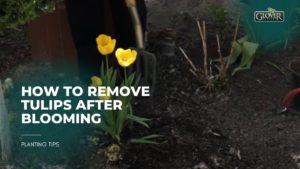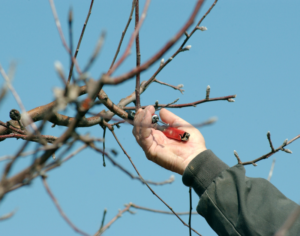Learning to co-exist with deer can be a challenge to even the most determined gardeners among us. Living in and near mountainous areas means that hungry deer are very often nearby, and they can do some serious damage to unprotected landscapes. Although no plant is deer-proof (Hungry deer will eat just about anything!) some plants are more resistant and less likely to find themselves as a tasty treat.
If you’re looking for ways to deter deer, check out this blog post: Deer Damage Protection and Recovery
And if you’re living in a high-elevation area and need plants that are both deer-resistant and reliably cold-hardy, visit our Plants for High Elevation Sites in Utah list.
Deciduous Shrubs that Deer Avoid
Deer may graze or try these plants, but generally avoid them.
- Barberry – Berberis thunbergii
- Beautybush – Kolkwitzia amabilis
- Bluebeard – Caryopteris
- Broom – Cytisus spp., Genista spp.
- Buckthorn – Rhamnus spp.
- Butterfly Bush – Buddleia spp.
- Coralberry – Symphoricarpos orbiculatus
- Cotoneaster – Cotoneaster spp.
- Deutzia – Deutzia spp.
- Dogwood – Cornus spp.
- Elderberry – Sambucus spp.
- Forsythia – Forsythia spp.
- Hydrangea – Panicle varieties – Hydrangea paniculata
- Lilac – Syringa
- Mock Orange – Philadelphus
- New Mexico Privet – Forestiera
- Privet – Ligustrum spp.
- Potentilla – Potentilla spp.
- Smoketree – Cotinus spp.
- Snowberry – Symphoricarpos spp.
- Spiraea – Spiraea spp.
- Sumac – Rhus spp.
- Viburnum – Viburnum spp.
- Weigela – Weigela florida
- Witch Hazel – Hamamelis spp.
Evergreen Shrubs that Deer Don’t Eat
Agave – Agave parryii
Bearberry/Kinnikinnick – Arctostaphylos uva-ursi
Boxwood – Buxus spp.
Daphne – Daphne spp.
Dwarf Spruce – Alberta, Globe Blue, Bird’s Nest – Picea spp.
Holly – Ilex spp.
Juniper – Juniperus spp.
Oregon Grape – Berberis formerly Mahonia
Manzanita – Arctostaphylos x coloradensis
Mountain Lover – Paxistima spp.
Silverberry – Elaeagnus commutata
Texas Red Yucca – Hesperaloe spp.
Yucca – Yucca spp.
Deer Resistant Vines
Clematis – Clematis spp.
Honeysuckle – Lonicera spp.
Boston Ivy – Parthenocissus tricuspidata
Grape – Vitus spp.
Trumpet Vine – Campsis spp.
Wisteria – Wisteria spp.
Shade and Flowering Trees that are Deer Resistant
Almost any young tree is susceptible to browse or trunk damage from deer. Young trees need to be protected until their trunks are thick enough to withstand any rubbing damage, especially between October and January. Trees with deer-attracting fruit can be limbed above 8 feet to avoid deer browsing. Deer typically avoid the following trees:
Beech – Fagus spp.
Birch – Betula spp.
Black Locust – Robina pseudoacacia
Catalpa – Catalpa spp.
Dogwood – Cornus spp.
Flowering Cherry – Prunus spp.
Ginkgo – Ginkgo biloba
Golden Raintree – Koelreutia paniculata
Honeylocust – Gleditsia triacanthos
-They may eat Honeylocust pods that fall to the ground
Magnolia, Southern – Magnolia grandiflora
Mimosa/Silk Tree – Albizia julbrissin
Oak – Quercus spp.
-May eat fallen acorns
Redbud – Ceris spp.
Serviceberry – Amalanchier spp.
Seven-Son Flower – Heptacodium miconoides
Sycamore/Planetree – Platanus occidentalis
Sweetgum – Liquidamber styraciflua
Tree Lilac – Syringa spp.
Tulip Tree – Liriodendron tulipifera
Willow – Salix spp.
Evergreens and Conifers that are Deer Resistant
Alaskan Cedar – Callitropsis nootkatensis
Arizona Cypress – Hesperocyparis arizonica
Arborvitae ‘Green Giant’ – Thuja plicata
Bald Cypress – Taxodium distichum
Blue Atlas Cedar – Cedrus atlantica
Cedar of Lebanon – Cedrus libanii
Dawn Redwood – Metasequoia glyptostroboides
Deodar/Himalayan Cedar – Cedrus deodora
Incense Cedar – Calocedrus decurrens
Giant Sequoia – Sequoiadendron giganteum
Juniper – Juniperus chinensis (Spartan, Spearmint), J. virginiana (Taylor)
*Deer may browse Utah Native species
– Common Juniper – Juniperus communis
– Rocky Mountain Juniper – Juniperus scopulorum
– Utah juniper – Juniperus osteosperma
Larch – Larix spp.
Pine, Bristlecone – Pinus aristata, Pinus longeava
Pine, Japanese Black / Thunderhead – Pinus thunbergii
Pine – most species at limbed up above 8’
Spruce – Colorado/Blue – Picea pungens
Spruce – Most species – Picea spp.
Deer Resistant Perennials
While deer regularly eat hostas and daylillies, there are many perennials and biennials that deer will pass over. These plants are either aromatic or toxic in ways that deer detest, or have rough, textured or fine foliage that isn’t worth their trouble.
Full Sun Perennials
Achillea – Yarrow Aconitum – Monkshood
Allium – Ornamental Onion
Aethionema – Persian Stonecress
Agastache – Hyssop, Hummingbird Mint
Alcea – Hollyhock
Alyssum – Madwort
Anaphalis margaritacea – Pearly Everlasting
Antennaria – Pussytoes
Aquilegia – Columbine
Armeria – Thrift Artemisia – Wormwood
Asclepias – MilkweedAster – Aster
Aurinia – Basket of Gold
Baptisia – False Indigo
Berlandiera – Chocolate Flower
Boltonia asteroides – False Aster
Callirhoe – Winecups
Campanula – Bellflower
Catanache – Cupid’s Dart
Centaurea – Bachelor’s Button, Cornflower, Mountain Bluet
Centranthus – Jupiter’s Beard, Valerian
Ceratostigma – Hardy Plumbago
Cherianthus – Wallflower
Coreopsis – Tickseed
Dalea – Prairie Clover
Delphinium – Larkspur
Dianthus – Pinks, Sweet William
Digitalis – Foxglove
Echinacea – Coneflower
Echinops – Globe Thistle
Echium – Red Feathers
Epilobum (Zauschneria) – Hummingbird Trumpet
Erigeron – Fleabane Daisy
Erigonum – Buckwheat
Eryngium – Sea Holly
Eupatorium – Joe Pye Weed
Gaillardia – Blanket Flower
Gaura (Oenethera) – Whirling Butterflies, Wandflower
Geranium – Cranesbill
Geum – Avens, Prairie Smoke
Gypsophila – Baby’s Breath
Helianthus maximiliana – Maximilian’s Sunflower
Heliopsis – False Sunflower, Ox-Eye Daisy
Hibiscus moscheutos – Hardy Hibiscus, Swamp/Rose Mallow
Hymenoxys – Sun Dancer Daisy
Iberis – Candytuft
Iliamna – Maple Mallow
Iris – Bearded, Flag, German
Kniphofia – Red Hot Poker
Leontopodium – Edelweiss
Leucanthemum – Shasta Daisy
Liatris – Blazing Star
Linum – Blue Flax
Lupinus – Lupine
Lychnis – Maltese Cross, Rose Campion
Mirabilis – Desert Four O’Clock
Monarda – Bee Balm
Mondardella – Mountain Bee Balm
Papaver – Poppy
Paeonia – Peony
Penstemon – Penstemon
Perovskia (Salvia) – Russian Sage
Phlomis russeliana – Jerusalem Sage
Phlox – Phlox
Physostegia – Obedient Plant
Platycodon – Balloon Flower
Lavandula – Lavender
Melampodium leucanthum – Black Foot Daisy
Nepeta – Catmint
Oenethera – Evening Primrose
Origonum – Ornamental Oregano
Osteospermum – Avalanche Daisy
Ratibida – Mexican Hat
Rosmarinus (Salvia) – Rosemary
Rudbeckia – Black-Eyed SusanSalvia – Sage
Santolina – Lavender Cotton
Saponaria – Soapwort
Scabiosa – Pincushion
Scutellaria – Skullcaps
Sisyrinchium – Lucern Blue Eyed Grass
Solidago – Goldenrod
Sphaeralcea – Globe Mallow
Stachys – Lamb’s Ear
Symphotrichum – New England Aster
Teucrium – Germander
Thermopsis – Golden Banner
Tradescantia – Spiderwort
Zinnia grandiflora – Desert Zinnia
Shade/Partial Sun Perennials that Deer Avoid
Alchemilla – Lady’s Mantle
Anemone – Japanese Wand Flower
Aruncus – Goat’s Beard
Astillbe – False Goat’s Beard, False Spiraea
Bellis – English Daisy
Bergenia – Pigsqueak
Brunnera – Siberian Bugloss
Crocosmia – Montbretia
Dicentra – Bleeding Heart
Doronicum – Leopard’s Bane
Helleborus – Hellebore, Lenten Rose
Heuchera – Coral Bells
Polemonium – Jacob’s Ladder
Polygonatum – Solomon’s Seal
Pulmonaria – Lungwort
Thalictrum – Meadow Rue
Tiarella – Foam Flower
Trollis – Globe Flower
Ferns that Deer won’t eat
Christmas Fern – Polystichum acrostichoides
Lady Fern – Athyrium filix-femina
Male Fern – Dryopteris filix-mas
Ostrich Fern – Matteuccia struthiopteris
Painted Fern – Athyrium niponicum
Royal Fern – Osmunda regalis
Sword Fern – Polystichum munitum
Deer Resistant Bulbs that are Cold Hardy
Deer love to eat Tulips, but are not as enthused about these bulbs:
Allium – Allium spp.
Autumn Crocus – Colchium spp.
Bluebells – Hyacinthoides spp.
Camas Lily – Camassia spp.
Crocus – Crocus spp.
Daffodil – Narcissus spp.
Fritillaria – Fritillaria spp.
Grape Hyacinth – Muscari armeniacum
Grecian Windflower – Anemone blanda
Glory of the Snow – Chionodoxa spp.
Snowdrops – Galanthus spp.
Squill – Scilla spp.
Deer Resistant Groundcover
Arabis – Rock Cress
Ajuga – Bugleweed
Arenaria – Sandwort
Arctostaphylos uva-ursi – Bearberry/Kinnikinnick
Aubrieta – False Rock Cress
Cerastium – Snow-in-summer
Cornus canadensis – Bunchberry, Creeping Dogwood
Epimedium – Barrenwort
Galium odoratum – Sweet Woodruff
Lamium – Dead Nettle
Lewisia – Bitterroot
Lysimachia – Creeping Jenny
Marrubium – Horehound
Paxisitima spp. – Mountain Lover
Phlox subulata – Creeping Phlox
Sedum – Stonecrop
Sempervivum – Hens & Chicks
Tanacetum – Partridge Feather
Teucrium – Germander
Thymus – Creeping Thyme
Veronica – Creeping Speedwell
Vinca major, Vinca minor– Periwinkle
Deer Resistant Grasses and Grass-like Plants
The popular addition of grasses to the landscape not only introduces new shapes and textures, an added element of sharpness to planting beds that deer stay clear of. After all, they’re called “blades of grass” for a reason!
Acnatherum – Indian Ricegrass
Andropogon – Big Bluestem
Bouteloua – Grama Grass, ‘Blonde Ambition’
Calamagrostis – Feather Reed Grass, ‘Karl Foerster’
Carex – Sedges
Chasmanthium – Northern Sea Oats
Festuca – Fescue
Heliotrichon – Blue Oat Grass
Leymus – Wild Rye Grass
Nasella tenuissima formerly Stipa – Mexican Feather Grass
Panicum – Switchgrass
Schizachyrium – Little Bluestem
Sorghastrum – Indian Grass
Sporobolus – Prairie Dropseed, Sacaton Grass
What does Deer-Resistant actually mean?
Understanding what the concept of deer resistance really means is a good starting point because it can help you manage your expectations. First off, deer “resistance” does not mean deer “proof” – a hungry deer will always surprise you! Secondly, “resistance” can be understood in one of two ways: (1) resistant as in deer will tend not to browse a certain plant but might do so as a last resort; or (2) resistant as in deer may browse them but the plants are resistant to catastrophic damage resulting in death and in fact recover nicely. Defined in these ways, you might start to look at your landscape’s relationship to deer as not only resistant but approaching some degree of co-existence where deer visits are anticipated and managed.
A note about “Deer-Resistant Plant Lists”
First of all, a word of caution regarding deer resistant plant lists. While some lists are based on actual deer management science, most are compiled anecdotally and so come from someone’s personal experience with deer in a landscape. A lot of these recommendations are based on real success (or heartache!) with a certain plant, but always remember that deer may eat a certain plant in one area only to leave it alone in another; moreover, deer tastes vary by individual, by herd, by region, by season, and by the availability (or lack) of more appealing options. In other words, mule deer are full of surprises, so you might also find that many lists can be surprisingly contradictory.


